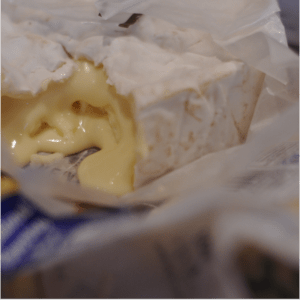18 year-old Sofia Radysh explains the challenges facing the popular delicacy

Popular varieties of cheese like Camembert, brie and blue cheese are at risk of disappearing due to a collapse of microbial diversity.
March 22, 2024
Camembert on the ‘verge of extinction’ – What does this mean for cheese production?
Camembert cheese – one of Normandy’s most precious exports, which entered the cheese market back in 1791 – is reported by the French National Centre for Scientific Research (CNRS) to be on the ‘verge of extinction’.
The fungus used to produce it, Penicillium camemberti, has a dangerous lack of genetic diversity.
What is Camembert?
Reminiscent of a window covered with frost, Camembert is a circular cheese with its outside covered with a white rind and gooey insides, but this type of look is relatively new.
Both Camembert and Brie used to come covered in grey or blue mould because they were aged in drying rooms where naturally occurring mould gave them this colour.
Why might this delicacy disappear?
The heart of the problem lies in the mould used to create everyone’s favourite cheese – Penicillium camemberti – which gives the cheese its beautiful flavour and easily identifiable smell of dirty socks.
The mould is experiencing trouble reproducing, mainly due to the pressures presented by the industrial manufacture of the cheese, where the production pace needs to meet very high supply demands.
Initially selected as one of the mutants for its white colour from the grey-green species of Penicillium commune at the start of the 20th century, researchers now find that genetic diversity is so low that the mould has declined capacity to reproduce sexually.
The asexual fungal cultivation process is problematic as well, because of the lack of genetic diversity in the mould’s DNA. The findings from a study conducted by scientists at Paris-Saclay University indicate that the use of a limited number of clonal strains ‘tends to lead to degeneration, limiting the possibilities for further improvement’.
What this means is that the albino strain can’t reproduce sexually, as most moulds do, so it can’t breed with another individual and therefore can’t create new genetic diversity. So in order to create more of this fungi it has to be cloned, which creates a genetically identical offspring.
According to the CNRS report, it is very difficult for manufacturers to ‘obtain sufficient amounts’ of the fungi spores to inoculate the production of Camembert.
Is this the first time a cheese might go extinct?
Certainly not and there were even some recent happy occasions of cheese varieties being ‘resurrected’. After more than 100 years of extinction, soft and crumbly Shropshire cheese made a comeback in 2017. After two years of intense work on the recipe, piecing the clues together, it entered the cheese market yet again.
Before trying to make the Shropshire cheese, nine months were spent culturing and re-culturing the natural starter for the cheese that was created in order for it to be the most authentic version possible. The cheese was finally presented at the Ludlow Food Centre and is now back on the market.
So, amid the worry, there is a chance that even if Camembert’s case is unsalvageable and it goes extinct, efforts will be put into its resurrection. But some working in cheese production are optimistic about its continued production.
Speaking with CNN, scientists and researchers of the study have themselves stressed that there is no “short-term danger” that Camembert is going anywhere anytime soon. Researcher Tatiana Giraud told CNN how “there is a great homogenization of starters and that this reduces their ability to adapt, nothing more.”



